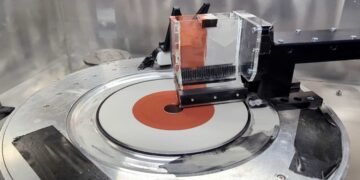
Formation of liquid crystals consisting of several layers that are the thickness of a hair strand. Functional particles created by phase separation between hydrophilic and hydrophobic liquids.
A research team in Korea has developed a material that may potentially replace color-shifting ink in prevention of forgery of banknotes, ID cards, and so on. A team headed by Dr. Sang-seok Lee from the Functional Composite Material Research Center of the Korea Institute of Science and Technology (KIST) announced that it has successfully developed a technology to fabricate liquid crystals[1] comprised of several layers with a thickness comparable to that of a hair strand using hydrophilic and hydrophobic properties through a joint study with a team led by Kim Shin-Hyun, Professor of Chemical and Biomolecular Engineering at the Korea Advanced Institute of Science and Technology (KAIST).

When a special additive called chiral dopant is mixed with the liquid crystal material commonly used in display devices, the liquid crystal molecules rotate spontaneously to form a spiral structure. This is referred to as “cholesteric liquid crystal[2],” a photonic crystal material that can exhibit color, without the addition of pigments, by selectively reflecting light of certain wavelengths due to its periodic nanostructure. Also, the light has a circular polarization[3] property in that it rotates in only one direction, and by using this property, it is possible to make colors appear and disappear by changing certain polarization conditions.
If this liquid crystal structure is repeated, it is possible to make a material that can exhibit two or more different characteristics at the same time. Liquid crystals with diverse optical characteristics from having multiple layers, for example, can be used as a material to prevent counterfeiting. However, to make such material consisting of several layers, there is a need to build each layer on top of the one before in a repeated fashion using an elaborately designed device, and there was a need to develop the technology for this complex process.
The KIST-KAIST research team added a cosolvent that dissolved in both oil and water as a way to mix organic alcohol, a hydrophilic moisturizing agent, and the hydrophobic liquid crystal material for all three substances to become evenly mixed together. Then, the mixture was emulsified[4] in water to form microemulsion drops. With the exchanges occurring among the cosolvent, moisturizing agent, and water molecules through the surfaces of the emulsion drops, this resulted in a separation of the hydrophobic and hydrophilic layers.
Depending on the initial mixing ratio of the substances, they separated into multiple layers ranging from one to five, and these layers could be freely controlled. Also, with the phase separation occurring continually within each emulsion drop, the concentration of the chiral dopant inside the liquid crystals changed, resulting in multiple structural colors. This is a new technology to fabricate liquid crystals of multiple layers through a simple process of emulsifying the mixture that has never before been reported.
Dr. Lee from KIST said, “What we’ve developed is a simple method of creating multi-layered liquid crystals and we expect it will serve as the basis for adding unique optical characteristics to materials,” and added, “Based on this new technology, we plan on developing diverse functional particles to develop composite materials.”
Glossary
- Liquid crystal: A substance with a combination of properties of liquid and solid matter.
- Cholesteric liquid crystal: A state in which liquid crystal molecules are in a spiral structure induced by chiral dopants.
- Circular polarization: A type of polarization where the tips of the vibration vectors of the light waves are in circular motion. (spiral movement considering the direction of light.)
- Emulsification: The process of creating an emulsion by evenly mixing liquids that do not naturally become mixed together by using a medium.




































